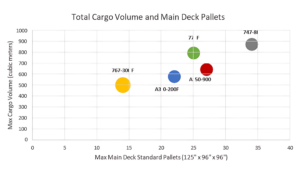
April 9, 2021
Can the A350-900F Compete with Boeing’s Line Up?
by Anna Kopinski
Recent reports have indicated that Airbus is considering creating a new entrant into the freighter aircraft market based on the A350-900. The factory freighter space has never been a major order success for Airbus with the OEM’s order book standing at around 140 freighters compared to Boeing’s 800+ factory freighters, excluding MD and DC aircraft. Of those 140 orders, nearly all were for Airbus’s A300 variants and orders for Airbus’s current freighter offering, the A330-200F, halted in 2015, without a new delivery of the type since February 2017, though orders for passenger-to-freighter conversions A330s have increased.
While the A350 is Airbus’s best freighter option, mba considered how this freighter would compete with Boeing’s strong factory freighter line up. The A350-900 passenger variant currently has a maximum payload of roughly 55 tons which is similar to the smaller Boeing 767-300F , while the A330-200F’s max payload is 70 tons. On the larger side the Boeing’s 777F and quad-engine 747-8F have max payloads of nearly 104tons and 132.6 tons, respectively.
There is a linear tradeoff relationship between the Max Take-Off Weight (MTOW) and the Max Zero Fuel Weight (MZFW), which is the maximum weight the aircraft is permitted to carry before fuel is loaded: the higher the MZFW, the less fuel it can carry when fully loaded, impacting its range capabilities. The A350 has a MZFW of 195.7 tons compared to its designed MTOW of 280 tons. This leaves a fully loaded A350 with 84 tons of fuel uplift, allowing for significant range capability at its current max structural load.
In previous freighter programs, whether factory or converted, the MZFW has been increased to allow for greater payload while reducing fuel lift capability, which is often excess to many mission profiles. The 767-300ER passenger variant had a MZFW of 126.1 tons, while the 767-300F factory freighter has a MZFW of 140.16 tons, an 11.1% increase. The A330-200 passenger variant had a MZFW of 170 tons, while the factory-built A330-200F was structurally reinforced to increase its MZFW to 178 tons, a 4.7% increase. More recently the 777-300ER freighter conversion program increases the MZFW of the aircraft to 253t allowing for 16t of additional payload. Airbus would likely also seek to increase the MZFW which would allow the max structural payload (cargo payload) to increase between 65-80 tons, making it a stronger candidate for a production freighter.
The aircraft has the potential for 26-27 full standard (96” x 125”) pallets on its main deck, with an additional 11 in the lower deck. However, the smaller fuselage dimensions (width and height) of the A350 would have different cargo contours despite the additional main deck positions which effects overall volume.

Assuming product escalation from now until delivery the Current Market Value of a 2026-build A350-900 freighter would likely fall under the 777F and would offer an increased trip efficiency with the per kilo efficiency to be ultimately determined by the aircrafts final configuration and by the specific mission. With efficiency requirements coming into play in 2028, possibly restricting the future delivery of the 777F and the 767-300F, the A350-900 appears be a great candidate to provide freighter capacity into the next decade and beyond. However, with many freighter operators in the process of updating and expanding fleets over last and upcoming five years, the question remains whether the A350-900F could see the same order book success the 777F was able to command. With over 200 orders for the 777F from major freight carriers over the last decade and an economic life of around 35 years, many operators may not be looking to bring a new aircraft type into their fleets or replace their current fleets for many years to come. While it remains to be seen how operators will approach a new entry into the widebody freighter space, the A350-900 is Airbus’s best opportunity to disrupt Boeing’s stronghold on the cargo market.

